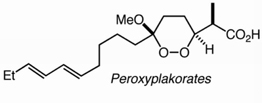Department of Chemistry
Date of this Version
2015
Citation
J. Org. Chem. 2015, 80, 12100−12114
Abstract
Although transfer of electrophilic alkoxyl (“RO+”) from organic peroxides to organometallics offers a complement to traditional methods for etherification, application has been limited by constraints associated with peroxide reactivity and stability. We now demonstrate that readily prepared tetrahydropyranyl monoperoxyacetals react with sp3 and sp2 organolithium and organomagnesium reagents to furnish moderate to high yields of ethers. The method is successfully applied to the synthesis of alkyl, alkenyl, aryl, heteroaryl, and cyclopropyl ethers, mixed O,O-acetals, and S,S,O-orthoesters. In contrast to reactions of dialkyl and alkyl/silyl peroxides, the displacements of monoperoxyacetals provide no evidence for alkoxy radical intermediates. At the same time, the high yields observed for transfer of primary, secondary, or tertiary alkoxides, the latter involving attack on neopentyl oxygen, are inconsistent with an SN2 mechanism. Theoretical studies suggest a mechanism involving Lewis acid promoted insertion of organometallics into the O−O bond.


Comments
© 2015 American Chemical Society